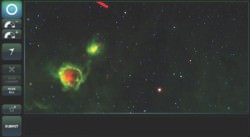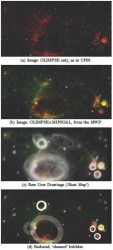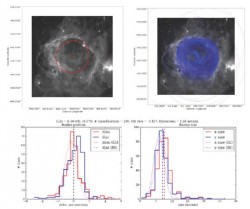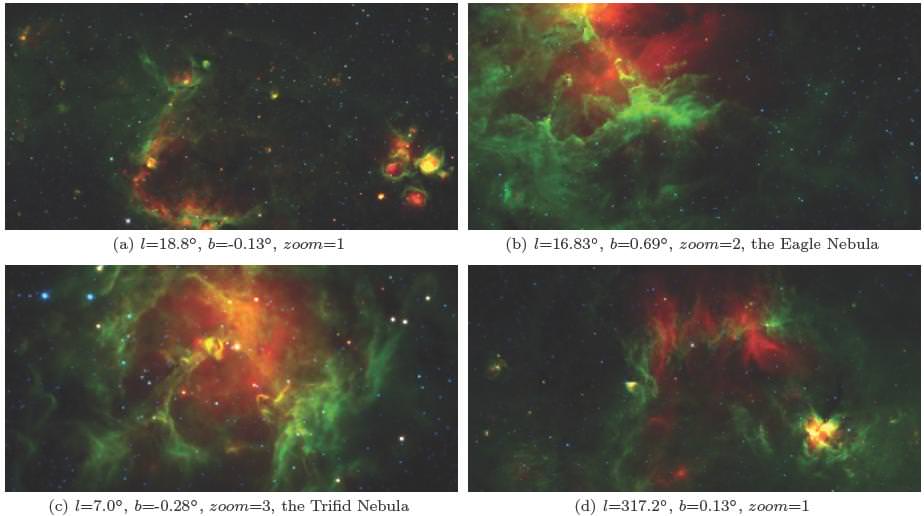[/caption]
Score another one for citizen science! In a study released just days ago, a new catalog containing over five thousand infrared bubble entries was added through the “Milky Way Project” website. The work was done independently by at least five participants who measured parameters for position, radius, thickness, eccentricity and position angle. Not only did their work focus on these areas, but the non-professionals were responsible for recovering the locations of at least 86% of additional bubble and HII catalogs. Cool stuff? You bet. Almost one third of the Milky Way Project’s studied bubbles are located at the edge of an even larger bubble – or have more lodged inside. This opens the door to further understanding the dynamics of triggered star formation!
Just what is the Milky Way Project? Thanks to the Galaxy Zoo and Zooniverse, scientists have been able to enlist the help of an extensive community of volunteers able to tackle and analyze huge amounts of data – data that contains information which computer algorithms might miss. In this case it’s visually searching through the Galactic plane for whole or broken ring-shaped structures in images done by Spitzer’s Galactic Legacy Infrared Survey Extraordinaire (GLIMPSE) project. Here the bubbles overlap and the structures are so complex that only humans can sort them out for now.

(API) tool set. The Zooniverse API is the core software supporting the activities of all Zooniverse citizen science projects.” says R. J. Simpson (et al). “Built originally for Galaxy Zoo 2, the software is now being used by 11 different projects. The Zooniverse API is designed primarily as a tool for serving up a large collection of `assets’ (for example, images or video) to an interface, and collecting back user-generated interactions with these assets.”
Through the interface, users mark the location of bubbles and other areas of significance such as small bubbles, green knots, dark nebulae, star clusters, galaxies, fuzzy red objects or simply unknowns. During this phase, the citizen scientist can make as many annotations as he or she wants before they submit their findings and receive a new assignment. Each annotated image is then stored in a database as a classification and the user can access their image again in an area of the website known as “My Galaxy”. However, images may only be classified once.

“In order to assist in the data-reduction process, users are given scores according to how experienced they are at drawing bubbles. We treat the first 10 bubbles a user draws as practice drawings and these are not included in the final reduction. Users begin with a score of 0 and are given scores according to the number of precision bubbles they have drawn.” explains the team. “Precision bubbles are those drawn using the full tool set, meaning they have to have adjusted the ellipticity, the thickness and the rotation. This is done to ensure that users’ scores reflect their ability to draw bubbles well. While only precision bubbles are used to score volunteers, all bubbles drawn as included in the data reduction. The scores are used as weights when averaging the bubble drawings to produce the catalogue.”
Now it’s time to combine all that data. As of October of last year, the program has created a database of 520,120 user-drawn bubbles. The information is then sorted out and processed – with many inclusions left for further investigation. However, not all bubbles make the cut. When it comes to this project, only bubbles that have been identified fifty times or more are included into the catalog. What remains is a “clean bubble” – one that has been verified by at least five users and picked out at least 10% of the time by the volunteers when displayed.
“It is not known how many bubbles exist in the Galaxy, hence it is impossible to quantify the completeness of the MWP catalogue. There will be bubbles that are either not visible in the data used on the MWP, or that are not seen as bubbles.” says the team. “Distant bubbles may be obscured by foreground extinction. Faint bubbles may be masked by bright Galactic background emission or confused with brighter nebular structures. Fragmented or highly distorted bubbles present at high inclination angles may not appear as bubbles to the observer.”

And that’s not all… “In addition to the reduced bubble catalogue, a crowd sourced `heat map’ of bubble drawings has also been produced. The MWP `heat maps’ allow the bubble drawings to be explored without them needing to be reduced to elliptical annuli. Rather, the `heat maps’ allow contours of overlapping classifications to be drawn over regions of the Galactic plane reflecting levels of agreement between independent classifiers. In most cases the structures outlined in these maps are photo-dissociation regions traced by 8 um emission, but more fundamentally they are regions that multiple volunteers agree reflect the rims of bubbles.”
Yep. They are bubbles alright. Bubble produced around huge stars when an HII region is hollowed out by thermal overpressure, stellar winds, radiation pressure or a combination of them all. This impacts the surrounding, cold interstellar medium and creates a visible shell – or bubble. These regions serve as perfect observation points “to test theories of sequential, massive star formation triggered by massive star winds and radiation pressure” and to keep us forever fascinated…
And forever studying bubbles.
Original Story Source: The Milky Way Project First Data Release: A Bubblier Galactic Disk. For Further Reading: The Milky Way Project Zooniverse Blog.

